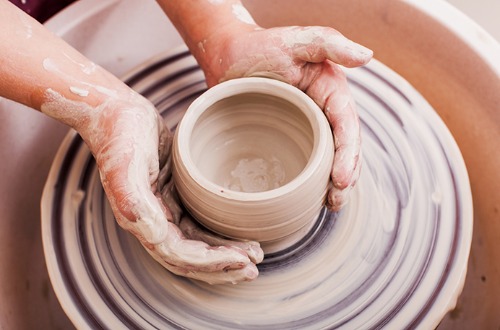Pottery is not only an art form where you directly touch and shape clay with your hands, but also a well-known healing activity that helps restore peace of mind. Korea boasts a world-renowned history of ceramics, such as Goryeo celadon and Joseon white porcelain, with a diverse development of traditional kilns and techniques. These days, pottery studios offer one- or two-hour one-day classes and hands-on experience programs, allowing beginners to easily touch clay and try their hand at shaping pottery. In this article, we’ll briefly explore the traditional Korean pottery culture and look into the joys and tips you can gain from participating in a pottery experience.
The Charm of Pottery Experience: Shapes Born at Your Fingertips
The essence of a pottery experience lies in the “tactile pleasure of touching clay” and the fun of watching it gradually transform into the shape you envisioned. At a pottery studio, you’ll typically find prepared clay, a potter’s wheel, carving tools, and more. Guided by the instructor’s demonstration, you’ll learn how to touch the clay while spinning the wheel. At first, you might press too hard or position your fingers wrong and collapse the shape, but with repeated attempts, you develop a sense for adjusting hand pressure and angles, and before you know it, you create a bowl that looks quite presentable.
Once you’ve shaped a bowl, cup, or small ornament, it’s dried, glazed, and fired in a kiln, resulting in a one-of-a-kind pottery piece that belongs only to you. In a one-day class, the kiln firing process can take several days, so it’s common for finished pieces to be shipped to you or stored at the studio for pickup. Regardless of the final form, the tactile satisfaction and moments of focus make it a truly special artistic experience.

The Beauty and History of Traditional Korean Pottery
The history of Korean pottery dates back to the Three Kingdoms period, but it truly flourished during the Goryeo and Joseon dynasties. Goryeo celadon is famous for its delicate jade-green color and inlay techniques, while Joseon white porcelain captivates with its simple yet dignified white tones. Knowing this historical background while participating in a pottery experience deepens the meaning—you might think, “The bowl I’m making right now is connected to a tradition that’s centuries old.”
Some studios also offer programs where you can apply simple celadon or white porcelain patterns in your designs. For example, after shaping the clay into your desired form, you might paint patterns with blue pigment or finish it with a clear glaze to enhance its beauty. While reproducing traditional techniques can be time-consuming, even a brief brushwork and pattern session can give you a glimpse into the aesthetics of Korean pottery.
Mindfulness and Healing Through Pottery
Pottery often unfolds like meditation. While spinning the wheel and touching clay, it’s hard for stray thoughts to creep in—you’re only focused on “right here, right now, this clay.” During that time, everyday stress fades, and you become fully immersed in the act of creation. Some people even prefer spending their time in silence, moving their hands and feeling the texture of the clay, rather than chatting with others in the studio.
Pottery is also often perfected through trial and error. Pressing the clay too hard may ruin its shape, yet you knead the clay again and try once more. This cycle can feel similar to life’s ups and downs, which is why some refer to pottery as a form of “training the mind.” In Korea, pottery experiences are embraced as more than just making souvenirs—they’re seen as a way to gently settle and quiet the mind.
Tips for Choosing a Pottery Studio and Preparing for the Experience
Pottery studios are popular in cities like Seoul, Busan, and Jeju—major tourist hubs—as well as in well-known art villages or cultural districts such as Insadong, Hongdae, and Tongyeong. It’s a good idea to book in advance, check the class size, program type, and language availability. Some studios may only offer instructions in Korean, so confirming whether they have English-speaking instructors can also be helpful.
It’s best to wear comfortable clothing that you don’t mind getting dirty. While clay generally washes out, it’s still wise to avoid white shirts or expensive outfits. Also, those with long nails might find wheel work challenging, so trimming them the day before is recommended. Many studios provide aprons, but bringing a change of clothes just in case is a good precaution.
The Joy of Receiving Your Finished Work
Keep in mind that in a one-day pottery class, you likely won’t be able to take your piece home the same day. The clay needs to dry, then be glazed and fired, which takes several days. If your trip is short, check whether the studio offers international shipping. Some studios provide delivery services for free or for a fee. When the finished pottery arrives at your home via international mail, you’ll be touched by the realization: “The time and touch I left in Korea have returned as this tangible creation.”
Some people use the bowls, cups, or planters they make as part of their daily lives. During meals, they might recall, “I made this myself at a pottery studio during my trip to Korea,” letting the memories flow back. Although the souvenirs are somewhat heavy and breakable, many feel the sentimental value is worth the extra effort.
Conclusion: Clay, Fire, and Your Own Work of Art
A pottery experience is a way to understand a part of traditional Korean culture through art born from the natural elements of clay and fire. The unique beauty of Korean ceramics is deeply rooted in history, and the fact that you can enjoy this tradition through modern experience programs adds to the appeal. Even in a relatively short time, you can intuitively enjoy the process of creating “something from nothing,” making it an unforgettable “hands-on experience unique to Korea” for travelers.
If you have a free day during your trip, consider choosing a pottery studio over a café or shopping. Unlike typical sightseeing spots, the pottery experience lets you enjoy the pleasure of creating your own value. Months later, looking at the planter that arrives at your home, you might find yourself immersed in the feelings of that day. For some, that alone can be reason enough for their trip to Korea to remain a shining memory.


WeBring Service : Provides personalized services to foreigners living in Korea
Exclusive offer: Introducing foreign car rental in Korea, WeBring-SoCar

